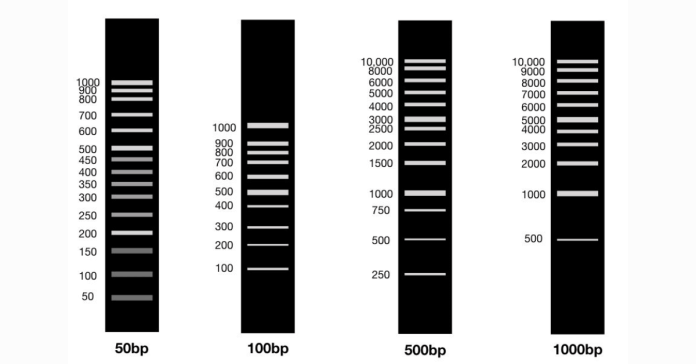If you’re familiar with working with DNAs, you must have heard about the equipment “DNA ladder.” Also known as the DNA molecular weight marker, the DNA ladder is the most widely used reagent in molecular biology.
Use Of DNA Ladder
The application of DNA ladder comes when gel electrophoresis (a technique that separates DNA fragments by their size) is required. The ladder typically helps scientists analyze the DNA bands’ size in their experiments by comparing them to the nearest fragment in the ladder.
Choosing The Appropriate DNA Ladder
However, in order to measure the DNA band sizes quickly and accurately, it is vital to use the correct DNA ladder. But with so many DNA ladders available, how do you choose the right one for your research? Let’s find out.
Determine its size range:
This is one of the most critical factors in choosing the right DNA ladder for your research. It is crucial to ensure that your DNA ladder’s range, from its smallest to its largest fragment, comprises the anticipated size of the DNA fragments you are experimenting with.
So, for instance, if you are expecting small DNA fragments of, let’s say, 50 base pairs (bp), then you must ensure the DNA ladder you choose includes bands at least that small.
On the contrary, if one of your samples comprises a large three-kilobase (kb) DNA fragment, you need to select a DNA ladder that contains bands as large as the DNA fragment.
Seek the number of bands in the particular size range:
Another crucial consideration is the number of bands in the ladder over your specific size range. When you use a ladder with more bands within a given size range, it is easier to precisely calculate the size of the DNA fragments in your research samples.
However, the only exception is that you must run the gel for an extended period to interpret a ladder with more bands visibly. So, if knowing the exact size of a band is essential, select a ladder with more bands and run your gel for an elongated time. If time constraint is the condition, or a rough estimation is enough, choose the one that doesn’t comprise as many bands.
In short, which DNA ladder is suitable for your research/experiment?
To summarize, scientists and researchers choose DNA ladders from various ladders based on their needs for their particular experiment. Besides, sometimes it also depends on the researcher’s preference as they like to experiment with different DNA ladders and determine which one they want the most.
The Wrap Up
DNA ladders are one of the most important and most commonly used equipment by scientists and researchers in molecular biology. However, there are scenarios in which choosing the right DNA ladder becomes crucial. In order to find the suitable one, researchers use specific parameters, from determining its size range to identifying the number of bands in the particular size range. On the other hand, sometimes it also comes down to scientists’ personal preferences and how they would like to experiment with particular DNA fragments in different DNA ladders to find the perfect fit.
Find Superior Quality DNA Ladders At MBP Inc.
If you’re in quest for high-quality, efficient DNA ladders, then MBP Inc. has got you covered. Our diverse range of DNA ladders allows scientists and researchers to produce reliable results in DNA analysis workflows.
From 1KB to large DNA ladders as well as DNA ladder 1kb plus intensity results demonstrate utmost precision and clarity whether you’re using it for PCR, gel electrophoresis, or DNA sequencing.
